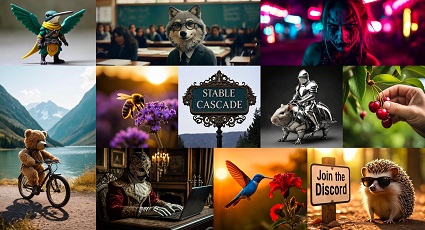Understanding the Stable Cascade Text-to-Image Conversion: A Deep Dive into Stable Diffusion AI
The incredible advancement of AI technology has led to new horizons in image generation, and one shining example is the technique of stable cascade text to image. This innovative approach uses Stable Diffusion AI to convert textual data into visually appealing and highly detailed images in real time. It's reshaping how we interact with digital spaces, breaking the barriers between words and visual representation. This article will guide you through an understanding of this AI-based technology, from what it is, to how you can apply it to bring your texts to life.
Part 1. What is Stable Diffusion AI?
1. Text-to-Image Generation:
Imagine describing a scene in detail, and then seeing a high-quality image appear that matches your description perfectly. That's the essence of text-to-image generation! Stable Diffusion AI excels at this task, analyzing textual descriptions and translating them into corresponding visuals.

2. Diffusion Models:
Diffusion models are a type of generative AI that work in a unique way. They start with a random image full of noise and gradually "de-noise" it, refining the image step-by-step until it transforms into a recognizable and meaningful picture. Stable Diffusion AI incorporates this approach but cleverly "guides" the de-noising process using the information extracted from your text input. This guidance ensures the final image aligns with the details and concepts you described, making it remarkably accurate and visually appealing.
Part 2. How Long Does It Take to Stable Cascade Text to Image?
The process of cascading text to image using Stable Diffusion AI is impressively rapid. However, the exact processing time can vary depending on the intricacy of the text data and the detail level in the desired output image. Generally, the system works meticulously to provide highly accurate visual representation in real time.
Part 3. How Do You Use Stable Cascade Text to Image?
Using stable cascade text to image is surprisingly intuitive and user-friendly. Here's an outline of the process:
1. Provide Textual Input
This is the heart of the process. You simply need to describe the image you envision in clear and concise language. The more details and specific information you provide, the more accurate and detailed the generated image will be. Think of it like painting a picture with words.
2. Refine Your Prompt (Optional)
After the initial image is generated, many tools allow you to refine the results. You can:
- Modify the text prompt: If the image doesn't match your vision perfectly, you can adjust your description by adding details, changing the style, or removing unwanted elements.
- Adjust parameters: Some tools offer various controls to influence the generated image. You might be able to adjust the artistic style (realistic, cartoon, etc.), modify the composition (landscape, portrait, etc.), or even control lighting and color palettes.
- Incorporate reference images (Optional): If available, some tools allow you to upload reference images that provide visual clues for the AI to guide the generation process. This can be particularly helpful when aiming for specific styles, objects, or emotions in the final image.
3. Generate and Refine
Once you're satisfied with your prompt and any adjustments, simply initiate the generation process again. Stable Diffusion AI will then analyze your refined prompt, reference image (if used), and generate a new image based on your specifications. You can repeat this process of refining the prompt and generating new images until you achieve your desired outcome.
Conclusion
Each of the mentioned Sora AI alternatives carries its uniqueness and set of compelling features catering to various user needs. As digital content consumption continues to evolve, having options enables users to find the perfect fit for their creative endeavors. I encourage you to delve into each of these alternatives and explore their unique offerings, enabling you to locate the tool that strikes the perfect balance for your specific requirements. Your ideal text-to-video AI tool could very well be a discovery away!

